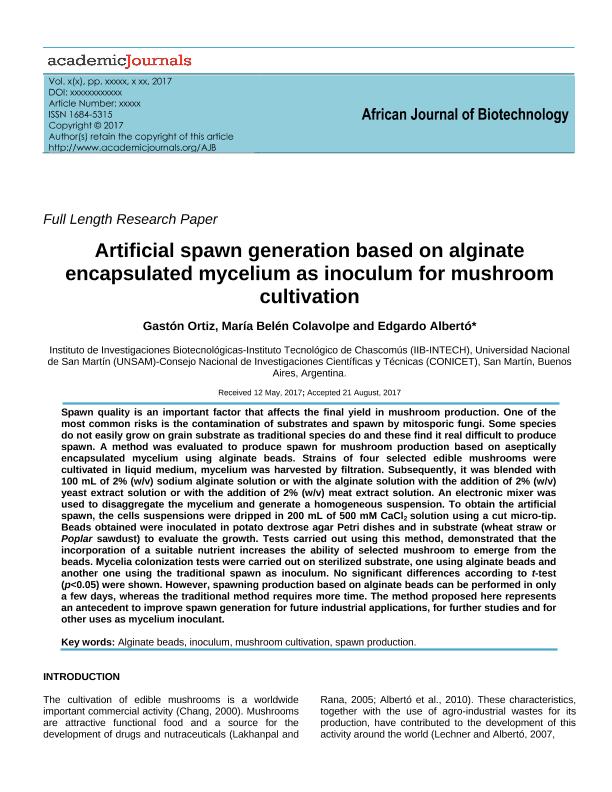Mostrar el registro sencillo del ítem
dc.contributor.author
Ortiz, Gastón Ezequiel

dc.contributor.author
Colavolpe, Maria Belen

dc.contributor.author
Alberto, Edgardo Omar

dc.date.available
2018-06-19T20:09:37Z
dc.date.issued
2017-08
dc.identifier.citation
Ortiz, Gastón Ezequiel; Colavolpe, Maria Belen; Alberto, Edgardo Omar; Artificial spawn generation based on alginate encapsulated mycelium as inoculum for mushroom cultivation; Academic Journals; African Journal of Biotechnology; 16; 34; 8-2017; 1776-1783
dc.identifier.issn
1684-5315
dc.identifier.uri
http://hdl.handle.net/11336/49448
dc.description.abstract
Spawn quality is an important factor that affects the final yield in mushroom production. One of the most common risks is the contamination of substrates and spawn by mitosporic fungi. Some species do not easily grow on grain substrate as traditional species do and these find it real difficult to produce spawn. A method was evaluated to produce spawn for mushroom production based on aseptically encapsulated mycelium using alginate beads. Strains of four selected edible mushrooms were cultivated in liquid medium, mycelium was harvested by filtration. Subsequently, it was blended with 100 mL of 2% (w/v) sodium alginate solution or with the alginate solution with the addition of 2% (w/v) yeast extract solution or with the addition of 2% (w/v) meat extract solution. An electronic mixer was used to disaggregate the mycelium and generate a homogeneous suspension. To obtain the artificial spawn, the cells suspensions were dripped in 200 mL of 500 mM CaCl2 solution using a cut micro-tip. Beads obtained were inoculated in potato dextrose agar Petri dishes and in substrate (wheat straw or Poplar sawdust) to evaluate the growth. Tests carried out using this method, demonstrated that the incorporation of a suitable nutrient increases the ability of selected mushroom to emerge from the beads. Mycelia colonization tests were carried out on sterilized substrate, one using alginate beads and another one using the traditional spawn as inoculum. No significant differences according to t-test (p<0.05) were shown. However, spawning production based on alginate beads can be performed in only a few days, whereas the traditional method requires more time. The method proposed here represents an antecedent to improve spawn generation for future industrial applications, for further studies and for other uses as mycelium inoculant.
dc.format
application/pdf
dc.language.iso
eng
dc.publisher
Academic Journals

dc.rights
info:eu-repo/semantics/openAccess
dc.rights.uri
https://creativecommons.org/licenses/by-nc-sa/2.5/ar/
dc.subject
Alginate Beads
dc.subject
Inoculum
dc.subject
Mushroom Cultivation
dc.subject
Spawn Production.
dc.subject.classification
Biotecnología Industrial

dc.subject.classification
Biotecnología Industrial

dc.subject.classification
INGENIERÍAS Y TECNOLOGÍAS

dc.title
Artificial spawn generation based on alginate encapsulated mycelium as inoculum for mushroom cultivation
dc.type
info:eu-repo/semantics/article
dc.type
info:ar-repo/semantics/artículo
dc.type
info:eu-repo/semantics/publishedVersion
dc.date.updated
2018-06-19T17:04:05Z
dc.journal.volume
16
dc.journal.number
34
dc.journal.pagination
1776-1783
dc.journal.pais
Kenia

dc.journal.ciudad
Nairobi
dc.description.fil
Fil: Ortiz, Gastón Ezequiel. Consejo Nacional de Investigaciones Científicas y Técnicas. Centro Científico Tecnológico Conicet - La Plata. Instituto de Investigaciones Biotecnológicas. Instituto de Investigaciones Biotecnológicas (subsede Chascomús) | Universidad Nacional de San Martín. Instituto de Investigaciones Biotecnológicas. Instituto de Investigaciones Biotecnológicas (subsede Chascomús); Argentina
dc.description.fil
Fil: Colavolpe, Maria Belen. Consejo Nacional de Investigaciones Científicas y Técnicas. Centro Científico Tecnológico Conicet - La Plata. Instituto de Investigaciones Biotecnológicas. Instituto de Investigaciones Biotecnológicas (subsede Chascomús) | Universidad Nacional de San Martín. Instituto de Investigaciones Biotecnológicas. Instituto de Investigaciones Biotecnológicas (subsede Chascomús); Argentina
dc.description.fil
Fil: Alberto, Edgardo Omar. Consejo Nacional de Investigaciones Científicas y Técnicas. Centro Científico Tecnológico Conicet - La Plata. Instituto de Investigaciones Biotecnológicas. Instituto de Investigaciones Biotecnológicas (subsede Chascomús) | Universidad Nacional de San Martín. Instituto de Investigaciones Biotecnológicas. Instituto de Investigaciones Biotecnológicas (subsede Chascomús); Argentina
dc.journal.title
African Journal of Biotechnology

dc.relation.alternativeid
info:eu-repo/semantics/altIdentifier/doi/https://dx.doi.org/10.5897/AJB2017.16065
dc.relation.alternativeid
info:eu-repo/semantics/altIdentifier/url/http://academicjournals.org/journal/AJB/article-abstract/CE0FC2165803
Archivos asociados
